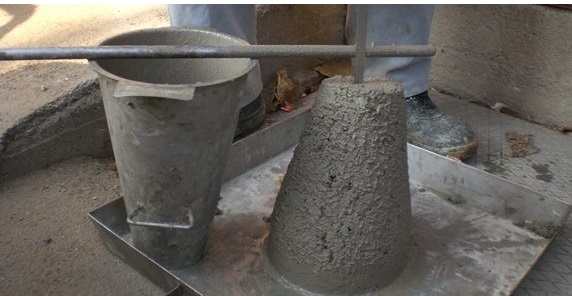The term “workability of concrete” refers to the ease with which freshly mixed concrete is placed, consolidated and finished without segregation.
According to the ASTM, workability is defined as “the property that determine the effort required to manipulate a freshly mixed quantity of concrete with minimum loss of homogeneity”.
Factors Affecting the Workability of Concrete
It is obvious that workability is a property of freshly mixed concrete. Therefore, it is affected by the properties and proportions of the concrete mixtures. Following is an outline of the factors affecting the workability of concrete.
1. Water Content [Water-to-binder Ratio]
Workability of concrete is directly proportional to the water content. In other words, the higher the water content in concrete, the higher is the workability as the water content per cubic meter of concrete would increase for higher water/binder ratios.
For a workable concrete, a water/binder ratio of 0.45 to 0.55 is generally used. However, it should be noted that there are detrimental effects for increasing the water content such as:
2. Cement Content
Cement content has a positive effect on the workability of concrete. Increasing the cement quantity leads to more available paste to coat the surface of aggregates and fill the voids between them. Accordingly, the friction between aggregates is reduced and thus, the movement of aggregates during mixing and placing of concrete would be smooth.
3. Cement Particle Size
Cements with finer particle sizes would require more water to achieve the same workability level.
4. Size and Shape of Aggregates
- It is well known that the size of a particle (such as aggregates) determines the its surface area. Consider a unit volume of aggregates, aggregates with small size would have higher surface area compared to those with large size. The point is that when the surface area increases, higher cement quantity is required to cover up the entire surface of aggregates with paste. Thus, more water is need to lubricate all aggregates. Hence, for a constant water content, lower sizes of aggregates are less workable than those with large size.
- Workability of concrete is also affected by the shape of aggregate. Aggregates exist in a variety of shapes such as angular, flaky, rounded, elongated …etc. Back again to the point of surface area, rounded aggregates have less surface area compared to elongated or irregular shaped aggregates; therefore,needs less water to achieve the same workability level. Moreover, rounded aggregates are easier to mix than elongated, angular and flaky aggregates due to less frictional resistance.
5. Aggregate-to-cement Ratio
The higher the aggregate/cement ratio, the leaner is the concrete. In lean concrete, less quantity of paste is required for providing lubrication. Hence, the mobility of aggregate is reduced, resulting in poor workability. On contrary, if more cement is used (lower aggregate/cement ratio), concrete becomes richer and aggregates will have proper lubrication for easy mobility or flow of aggregates.
6. Grading and Surface Texture of Aggregates
A well graded aggregates lead to reduced voids in a given volume of aggregates. Less volume of voids allow more cement paste to be available to cover the aggregate surfaces (better lubrication).
Surface texture (rough or smooth) of aggregates affects the workability of concrete in the same manner as the shape of aggregates. Rough texture leads to higher the surface area comparable to smooth texture.
7. Adding Admixtures to Concrete Mixtures
ِAdding workability enhancing admixtures such as water reducers (plasticizers and super plasticizers) increases the workability of concrete for the same water/binder ratio. Therefore, adding water reducers allows the reduction for the water/binder ratio to achieve the same workability level.
Moreover, Air entraining admixtures, which mainly used to give the concrete resistance to freezing and thawing, increase the workability.
8. Using Supplementary Cementitious Materials
SCMs such as fly ash can enhance the workability of concrete by reducing the water content required for same degree of workability or slump value.
